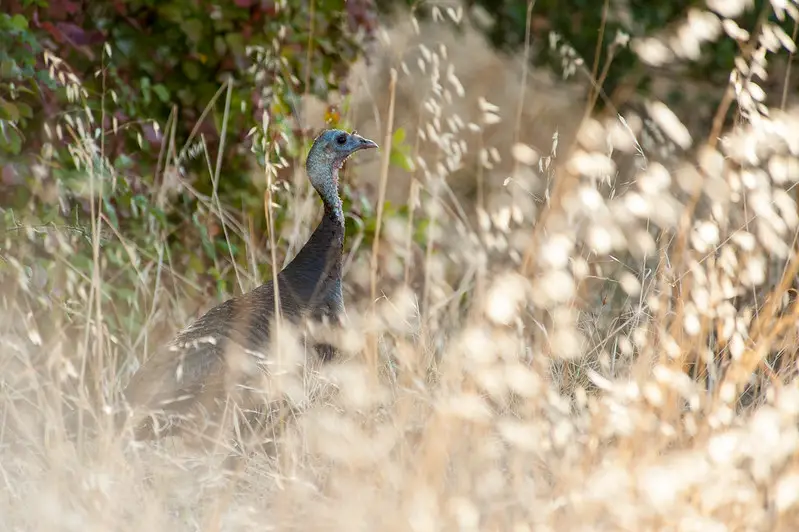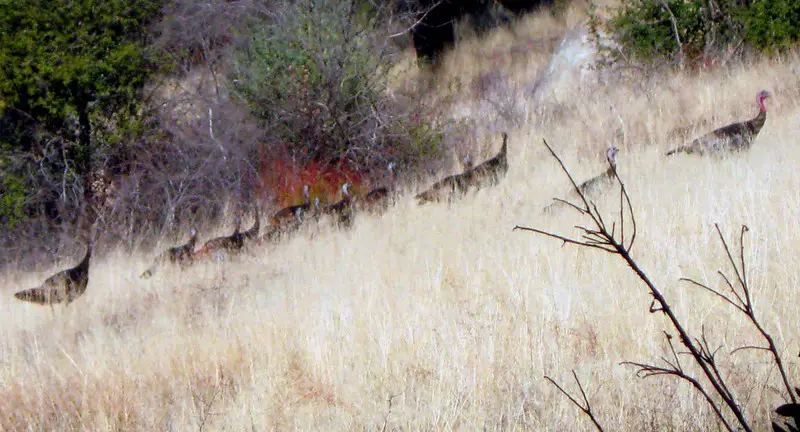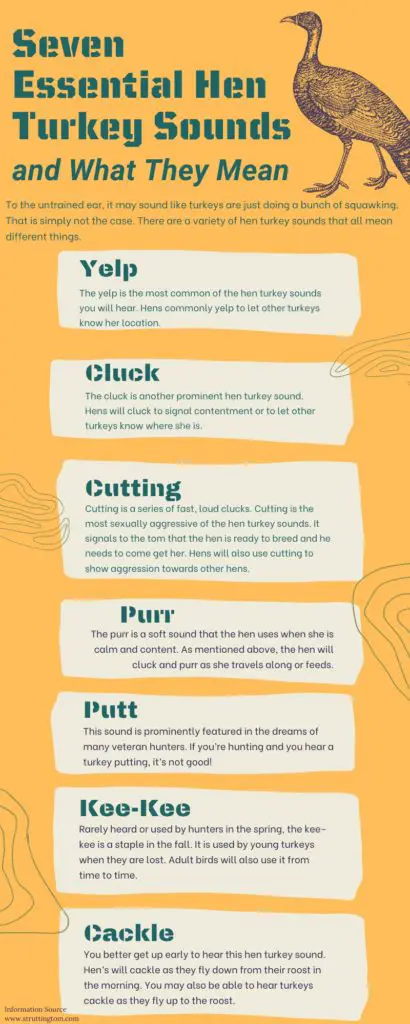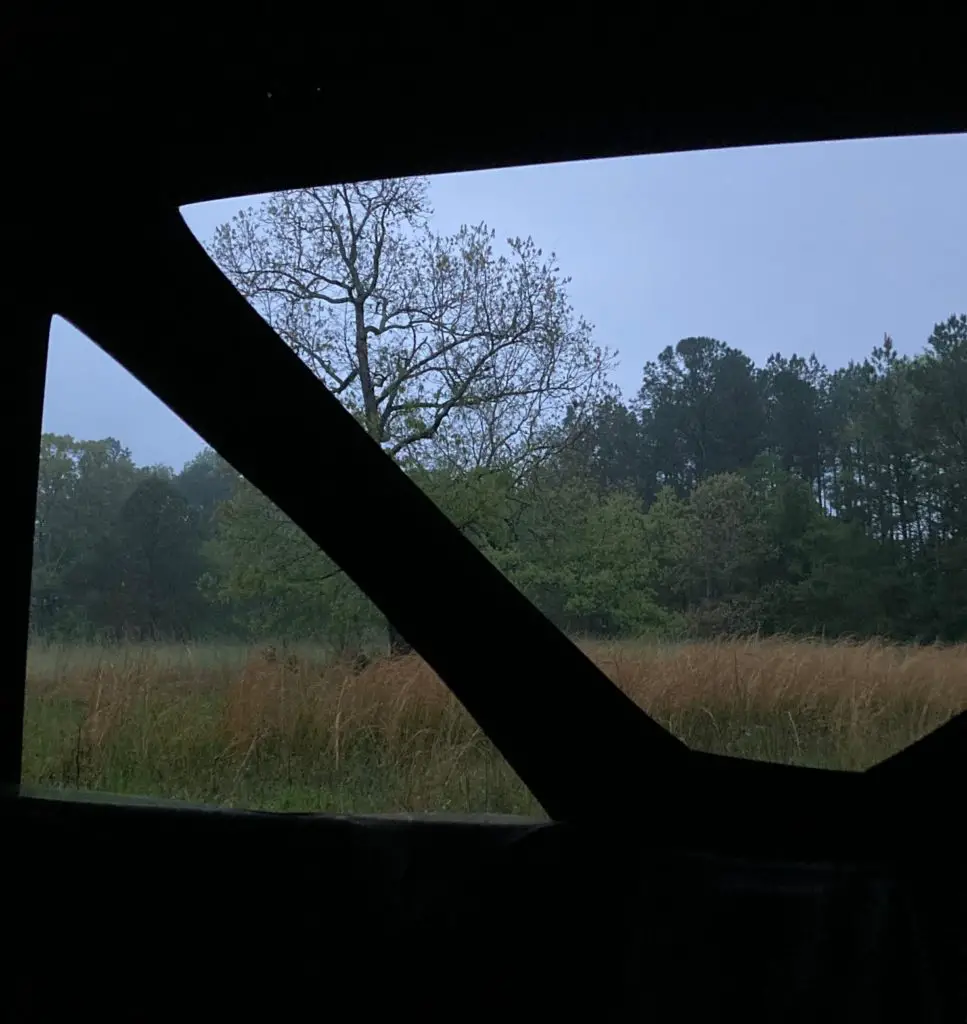
To the untrained ear, it may sound like turkeys are just doing a bunch of squawking. That is simply not the case. There are a variety of hen turkey sounds that all mean different things.
Learning to distinguish the different calls, what they mean, and when to use them will make you a much better hunter. This article covers seven different types of hen turkey sounds. There is a video or link to a video of each sound so you can hear and see for yourself a real turkey calling.
Yelp
The yelp is the most common of the hen turkey sounds you will hear. Hens commonly yelp to let other turkeys know her location.
You can hear a hen yelp in this clip. While hens typically yelp in three to seven-note strings, as you can hear in the video, they can create much longer strings. These strings are usually very uniform and rhythmic. Hens will also emit single yelps as well.
The emotion of a yelp can vary quite a bit. As a hen wakes up, she will make very soft, content tree yelps. This is in sharp contrast to the excited yelp you will hear in the spring as a hens answer gobbling toms. Hens will also use a loud series of assembly yelps to gather her flock together.
There are a variety of words hunters will use to imitate a yelp with a mouth call. “Yelp,” “chuck,” and “shock” are just a few of the words commonly used to humanize the turkey vocabulary.
Yelping is not exclusive to the female turkey. Toms will also yelp. This is an example of a jake yelping. Notice how the tone is deeper than most hen calls.
Cluck
The cluck is another prominent hen turkey sound. Hens will cluck to signal contentment or to let other turkeys know where she is.
Like the yelp, the cluck is also commonly used in a series. Unlike the yelp, it is less uniform and more erratic. The cluck can be heard in conjunction with purrs when a turkey is milling about at peace with the world. In the video below, you can hear this hen clucking and purring.
The cluck sounds very similar to a putt. As you will read below, the putt is a warning call signaling danger to other turkeys. Needless to say, you do not want to putt when you are calling. The cluck is a softer sound than the putt.
To make things even more confusing, many callers will use the word “putt” to vocalize the cluck on a mouth call. This is not improper. The key is to learn the proper context and intensity to generate a quality cluck.
Cutting
Cutting is a series of fast, loud clucks. Cutting is the most sexually aggressive of the hen turkey sounds. It signals to the tom that the hen is ready to breed and he needs to come get her. Hens will also use cutting to show aggression towards other hens.
This video features a hen cutting. Listen to how the hen breaks up the cutting. When I call, I cut by doing varying series of one to three clucks. It is not a machine gun sequence of clucks like you might hear some beginning callers making.
As you might imagine, cutting can have dramatic consequences when used in a hunting setting. It can be just the ticket for bringing in a fired-up gobbler, but it can also turn off a tom who is cautiously coming into a “hen” that has previously been soft calling.
Purr
The purr is a soft sound that the hen uses when she is calm and content. As mentioned above, the hen will cluck and purr as she travels along or feeds.
In my video above, you can hear the hen purring in between clucks. The sound is a soft sound that somewhat resembles someone trying to roll their r’s.
Hunters use purring calls to bring in a cautious tom. The hope is that the wary gobbler will believe that everything is peachy when he hears the purrs.
Toms also make a similar sound when fighting other toms. Known as fighting purrs, these louder, sharper noises denote aggression towards rival gobblers.
Putt
This sound is prominently featured in the dreams of many veteran hunters. If you’re hunting and you hear a turkey putting, it’s not good!
The turkey putt is an alarm call similar to a deer snorting or an elk barking. As you will hear in this video, it is very similar in sound to the cluck. You can differentiate by the sharpness of the tone. A turkey will also usually putt faster than it will cluck.
Needless to say, avoid putting when you are calling to a turkey.

Kee-Kee
Rarely heard or used by hunters in the spring, the kee-kee is a staple in the fall. It is used by young turkeys when they are lost. Adult birds will also use it from time to time.
The kee-kee consists of three to four whistle-type noises. The kee-kee run is a kee-kee followed by a series of yelps. You can listen to what that sounds like in this video.
During the fall, hunters will break up flocks of birds using a number of methods including dogs. The hunter will then attempt to call the flock back together. This is a good time to use the kee-kee or kee-kee run. Though there are some spring situations when a kee-kee might come in handy, it is rarely used by spring hunters.
Cackle
You better get up early to hear this hen turkey sound. Hen’s will cackle as they fly down from their roost in the morning. You may also be able to hear turkeys cackle as they fly up to the roost.
The call is similar to a cut, but the rhythm is different. It begins with some soft clucks and accelerates to loud rapid clucks before slowing back down. In this video, you can see how the cackle is timed with the fly down.
The cackle is one of my favorite hen turkey sounds to hear from the competitive callers on stage. For the hunter, you don’t have to be a master of this call to kill turkeys. It can make for a realistic setup if you can pull it off though.

Learning these Hen Turkey Sounds
As we’ve discovered, hens make a variety of sounds that carry many different meanings. Listen carefully the next time you are in the woods or watching a hunting video and try to distinguish the different calls. You can also download a turkey calling app to listen to hen turkey sounds wherever you go.
The better you can recognize each call, the better you will be able to recreate the sound in your own calling. As with everything, practice, practice, practice. Good luck out there!



Pingback: My Favorite Free Turkey Calling App - Strutting Tom.com
Pingback: How to Roost a Turkey for a Better Hunt - Strutting Tom.com
Pingback: 5 Turkey Hunting Tips to Kill Your First Longbeard - Strutting Tom.com